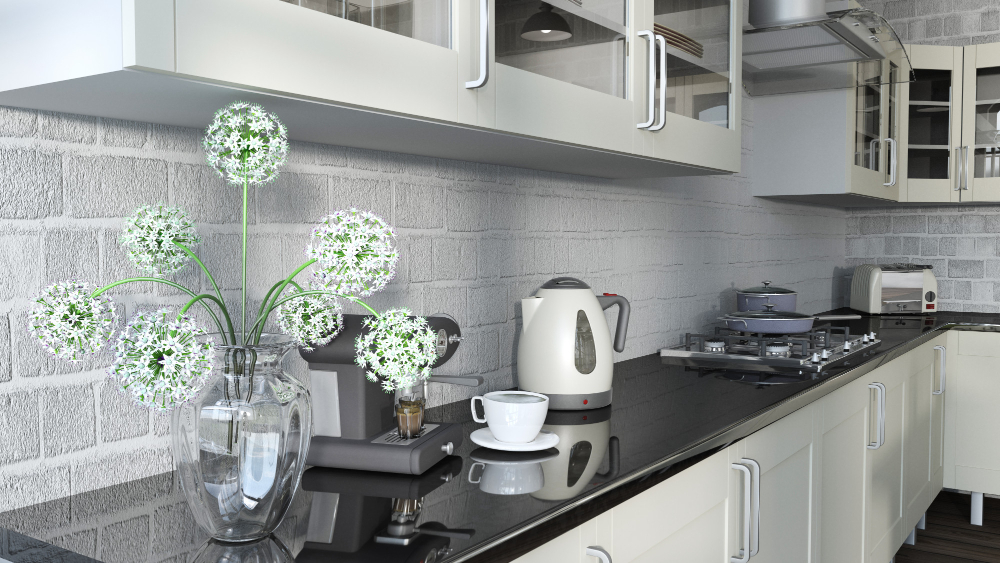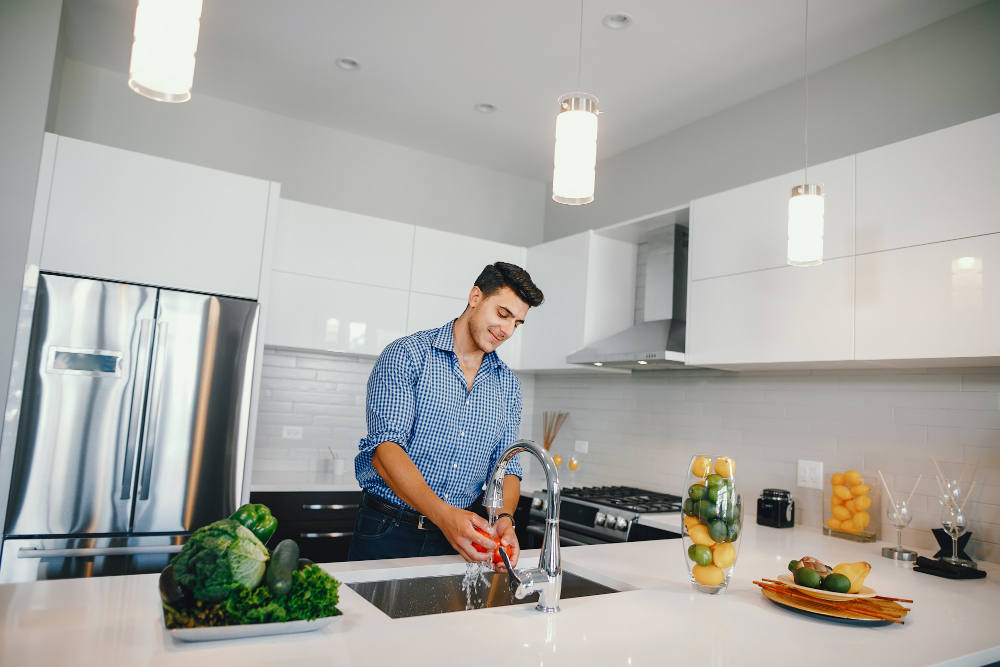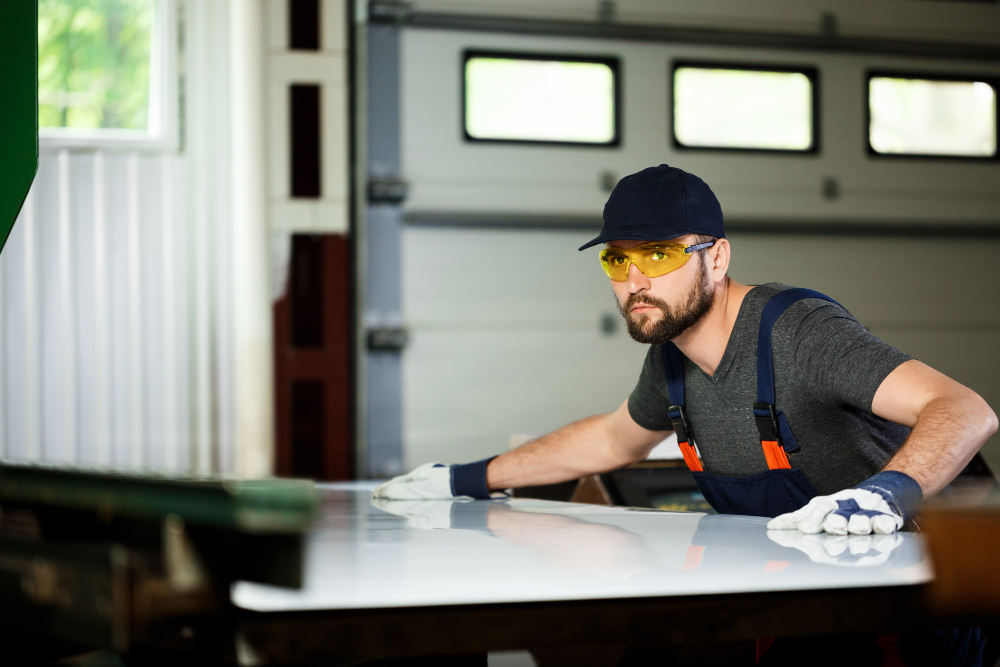A glass splashback is not just a protective element for your kitchen walls; it’s a statement piece that adds elegance and style to your cooking space. With its sleek surface and easy maintenance, a glass splashback is an excellent choice for modernizing your kitchen. Here we know the process of installing a glass splashback in Your Kitchen, ensuring you achieve a perfect finish that is both functional and visually appealing.
Detailed Materials and Tools Needed to Install a Glass Splashback
- Glass Splashback: Opt for toughened glass, which is heat and impact-resistant, ensuring durability and safety. The glass should be custom-cut according to your kitchen’s specific measurements, including cutouts for outlets or switches if required.
- Measuring Tape: For accurate measurements of the area where the splashback will be installed.
- Level: To ensure the splashback is perfectly horizontal or vertical, depending on its orientation.
- Silicone Adhesive: A high-quality, waterproof adhesive suitable for glass and your wall material.
- Alcohol Wipes: For cleaning the wall and the back of the glass splashback before installation.
- Masking Tape: To mark the wall and temporarily hold the splashback in place.
- Caulking Gun: For applying the silicone adhesive and sealant.
- Safety Gloves and Glasses: To protect your hands and eyes during the installation process.
Step By Step Installing a Glass Splashback in Your Kitchen

Step 1: Accurate Measurement and Preparation
Exact Measurements: Measure the width and height of your intended splashback area. Include allowances for any necessary cutouts (e.g., sockets, switches) and expansion gaps (typically 2-3mm).
Wall Condition: Ensure the wall is flat and free from any damage. Repair any cracks or holes and sand any uneven surfaces.
Surface Cleaning: Clean the wall thoroughly with a degreaser or alcohol wipes to remove any dirt, grease, or residue.
Priming: If applying over a porous surface like plaster or wood, apply a primer to seal the surface and ensure better adhesion.
Glass Specification: Confirm the glass is toughened (tempered) for safety and durability, especially behind heat sources like stoves.
Step 2: Dry Fitting and Positioning
Dry Fit Test: Place the splashback against the wall to ensure it fits perfectly, accounting for any necessary adjustments.
Mark the Position: Use a pencil or low-tack masking tape to outline the splashback’s position on the wall, ensuring it aligns with your measurements.
Level Alignment: Use a spirit level to ensure the splashback will be perfectly horizontal or vertical. Adjust your markings if necessary.
Check for Obstructions: Identify and make provisions for any obstacles, such as power outlets or switches, ensuring the splashback does not interfere with their use.
Final Placement Review: Confirm there is a uniform gap around the edges of the splashback for the application of sealant, adjusting the position if necessary.
Step 3: Adhesive Application
Choosing Adhesive: Select a high-quality, neutral-cure silicone adhesive that’s compatible with both the glass and the wall surface.
Applying Adhesive: Apply the adhesive in vertical lines or a zigzag pattern to ensure coverage and allow air to escape when pressing the splashback into place.
Edge Consideration: Leave a small margin (about 1-2 cm) around the edge of the splashback without adhesive to prevent it from oozing out when pressed against the wall.
Even Distribution: Use a notched trowel to spread the adhesive evenly, ensuring consistent thickness across the splashback.
Immediate Use: Once the adhesive is applied, do not delay in mounting the splashback to prevent the adhesive from skinning over, which can reduce its effectiveness.
Step 4: Secure Installation
Careful Alignment: Gently place the splashback against the wall, aligning it with the marks you’ve made. Start from the bottom and gently tilt it into place to avoid trapping air.
Even Pressure: Press the splashback against the wall, starting from the center and working outward to ensure any air pockets are expelled.
Use Spacers: If necessary, use small spacers along the bottom edge to maintain an even gap between the splashback and countertop for sealing.
Temporary Support: Secure the splashback with masking tape across the top and sides to hold it in place as the adhesive cures.
Inspection: Check the alignment with the level again after installation to ensure it remains straight and adjust if necessary before the adhesive sets.
Step 5: Final Sealing
Sealant Preparation: Once the adhesive has fully cured, prepare to seal the edges with a waterproof silicone sealant.
Applying Sealant: Apply a bead of sealant around the edges where the splashback meets the wall, ensuring complete coverage to prevent water ingress.
Smoothing Sealant: Wet your finger, or use a sealant tool, to smooth the sealant bead for a neat, professional finish.
Tape for Clean Edges: Apply masking tape to both the wall and the splashback before sealing for a straight edge, removing the tape immediately after smoothing.
Curing Time: Allow the sealant to cure fully according to the manufacturer’s instructions before cleaning or using the area to ensure a durable, waterproof bond.
Additional Installation Tips to Install a Glass Splashback

1. Proper Measurement Technique
Measure the intended area for your splashback at least twice to ensure accuracy. Consider any slight irregularities in wall angles or surfaces. Accurate measurements are crucial for a custom-fit glass splashback, leaving minimal gaps and avoiding the need for adjustments during installation.
2. Selecting the Right Glass
Opt for toughened (tempered) glass, which is four to five times stronger than standard glass and can withstand high temperatures, making it ideal for kitchens. This safety feature is vital, as it ensures the glass will crumble into small, blunt pieces if broken, reducing the risk of injury.
3. Preparing the Surface
Ensure the wall surface is thoroughly prepared before installation. This means the wall should be clean, dry, and smooth. Any bumps or rough patches can prevent the splashback from sitting flush against the wall, leading to potential stress points that could crack the glass.
4. Adhesive Application
When applying adhesive, aim for a balance between too much and too little. Excessive adhesive can cause the splashback to sit too far from the wall, while insufficient adhesive might not hold the splashback securely. The right amount ensures a firm bond and a clean look without oozing out from the edges.
5. Preventing Air Bubbles
To avoid trapping air bubbles behind the splashback, which can create unsightly blemishes and potentially weaken the adhesive bond, press the glass evenly and firmly against the wall from the center outward. This technique helps expel any trapped air through the edges.
6. Dealing with Excess Silicone
If any silicone adhesive or sealant squeezes out from behind the splashback or around the edges, clean it up immediately with a damp cloth. Silicone can be difficult to remove once it’s cured, and prompt cleanup ensures a neat, professional finish.
7. Allowing for Expansion
Glass can expand and contract with temperature changes. Leave a slight gap (usually 2-3 mm) around the edges of the splashback to accommodate this movement. This gap, filled with silicone sealant, also helps prevent the glass from cracking.
8. Safety Precautions
Always wear protective gear, including safety glasses and gloves, when handling and installing glass splashbacks. The edges of the glass can be sharp, and the risk of accidental breakage is present. Safety gear protects against cuts and other injuries.
9. Regular Maintenance
Keep your glass splashback looking new by cleaning it regularly with a non-abrasive cleaner and a soft, lint-free cloth. Avoid harsh chemicals that could damage the glass or dull its finish. Regular cleaning also prevents the buildup of grease and other substances that can be harder to clean over time.
10. Inspection and Repair
Periodically inspect the sealant around the splashback for any signs of wear, such as cracking or peeling. A compromised sealant can allow moisture behind the splashback, potentially causing damage to the wall. Promptly repair any issues to maintain the splashback’s appearance and integrity.
Conclusion
By incorporating these detailed points into each step, you can ensure a thorough, successful installation of your glass splashback, enhancing both the functionality and appearance of your kitchen. This approach not only guarantees a more precise and secure installation but also addresses potential challenges, ensuring a durable and attractive finish.

